The Cat Returnsby: Roarkiller

The latest movie from the production line of Studio Ghibli,
Neko no Ongaeshi is a light-hearted movie as digestible as chicken soup. Directed by Morita Hiroyuki, the movie is based on the manga
Baron, Neko no Danshaku by Hiiragi Aoi, who is also the author of
Mimi wo Sumaseba and its sequel
Mimi wo Sumaseba: Shiawase na Jikan.
Neko no Ongaeshi is similar to the critically-acclaimed movie
Sen to Chihiro no Kamikakushi by Miyazaki Hayao in the sense that it begins in normal Japan and shifts to a parallel world later in the story. There, the similarity stops and a whole new adventure begins.
The story is about a typical Japanese girl Haru who seems to have a nack in getting into mishaps. One day, she saves a cat from being run over by a truck. The cat turns out to be the prince of the Cat Kingdom and, in return of the favor, the king has decreed that the whole kingdom tries its best to repay her kindness. Unfortunately for her, none of the 'gifts' were fitting for a human, and to add to her troubles, she was also decreed to be married to the prince that she saved.
The movie in general borders along humor and fantasy, leaning more towards the former. Haru's naiveness and the antics of the cats will definitely put a smile and a laugh into your mouth. No one is evil and there are no bad guys. In fact, the worst character is simply an over-eccentric father whose acts seem to be more on the naughty side than evil.
The storyline is simple yet entertaining, the animation splendid as is the trademark of Studio Ghibli. The music is enlightening, although one might notice, if observant enough, that some of the music pieces are recycled from the movie Mimi wo Sumaseba. The theme song, done by Tsuji Ayano, has such a great feel-good factor that it will remain playing in your head long after you come out of the theatre.
It's hard not to like this movie, and although it is definitely not in the same level as movies like
Kaze no Tani no Nausicaa and
Tenkuu no Shiro Laputa, you definitely would not want to miss this movie either. If may not be a Miyazaki movie, but it is still a Ghibli movie, and that alone is reason enough to watch it.
Grave of the FirefliesHeartrendering, moving masterpiece from Isao Takahata, and a triumph for animation.
by: Jon Turner

Truly one of Studio Ghibli's greatest crowning achievements, GRAVE OF THE FIREFLIES is a brilliant masterpiece fully deserving of a place in any of the best movies ever made. Not just an astonishingly great (and, at the risk of coming off as clich�perfect) work of art, this is a moving, thought-provoking, and ultimately heartbreaking tale about the loss of innocence and the tragedies of war.

Based on an autobiography by Akiyuki Nosaka, the film, set during the bombing of Japan in --of all times-- World War II, centers on Seita, a loving, headstrong Navy soldier's son and his innocent little sister, Setsuko. Their fatal struggle for survival begins right at the start, when both are bombed out of house and home by American B-29s. Mom is seriously wounded and found wrapped in bandages at a hospital, where she dies shortly after. The children move to Nishinomiya to stay with their aunt. Auntie, a cold, bitter, self-serving woman, has no patience with Seita or Setsuko, especially when they would rather chase after fireflies at moonlight, play by the beach, or lounge around the house instead of helping out. After butting heads with Auntie long enough, the children decide to run away, setting up home in an abandoned cave by the lake. Both try by all means to live off of vegetables or whatever food they can afford to trade and/or steal, to no avail....
The outcome of the story is actually showcased at the opening of the movie, where we see a ghostly specter of Seita watching a more malnourished version of himself die a painful, lonely death at a train station. Indeed, as we see how these events came to pass, we find ourselves rooting for Seita and Setsuko to find a way to stay alive, but alas, it is not to be, given Seita's stubborn pride. The overall tone of the movie is of a very tragic nature--even such lighthearted moments as the aforementioned sequences involving Seita and Setsuko playing around the house or gathering fireflies as lights for their cave are all tainted with a touch of sadness, for we know that these brief scenes of happiness will not last.

Who is to blame for the plight of these children? The movie never addresses this question to the audience, nor does it really care to. It would be easy for director Isao Takahata to make this an anti-American movie, but he does better than that. Instead, he aptly conveys that war can spell serious--and deadly--consequences for victims. He also eschews casting any character as a hero or villain, and instead makes this a very human story, with no clear-cut "good" or "bad" characters. The aunt, for example, is not evil; she is merely an angry, desperate woman who is only struggling to survive just as much as Seita and Setsuko are. Atrocious as her treatment of the children is, we somehow never see her as a true baddie, but a very flawed, multi-faceted human being.

Normally one would think of this kind of story as suitable for live-action, but GRAVE OF THE FIREFLIES proves that it can be told through the art of animation as well. This is no mindless showcase of gorgeous visuals--although the artistic merits of the movie are, as with Ghibli productions, sumptuous and at times breathtaking--but a display of real characters struggling with very tangible emotions. And the most amazing accomplishment about this movie is how much we grow to care for Seita and Setsuko--their inseparable bond of love and companionship is the heart and soul behind the movie.
There are long stretches of silence on the soundtrack, with music used very sparingly, yet the movie is all the more powerful for it. The most effective moment is where we hear a scratchy rendition of "Home, Sweet Home" over a montage of Setsuko playing by the shelter. It's a simplistic, sweet, yet very saddening moment that not only works in the context of the movie, but on its own as well.
I don't normally say this in my reviews, but I would definitely recommend watching this movie in its native language of Japanese for a truly powerful and memorable experience. That's not to imply, however, that the English dub is inferior; on the contrary. It is, in fact, surprisingly good, with an effective lead in J. Robert Spencer and noteworthy cameo appearances by Anime voiceover actors Veronica Taylor, Crispin Freeman, and Dan Green. Rhoda Chrosite's Setsuko is the one voice that doesn't fare so well; she sounds more like an adult pretending to be a young girl, and comes across as strained during most scenes (save for when she is sick from diarrhea). Still, for those who can't read subtitles, the dub is more than adequate (although not as high-profile as others that I've heard).
Even in a genre as multi-faceted as Japanese Anime, there are few films that literally everyone really MUST see. GRAVE OF THE FIREFLIES is one such movie.
Howl's Moving Castle
by: Johnny Du
While computer animation is kicking hand drawings to the curb in the U.S., it's nice to see that the classical animation form still thrives in Japan. What strikes me about Howl's Moving Castle is just how colorful it is. Studio Ghibli shows no signs of slowing down When it 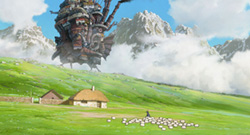 comes to creating gorgeous panoramic scenes, diverse character designs and finishing things off with a flourish when the colors are applied. It can't be underestimated how the wide range of colors used in this film really help things stand out even more and accentuate the fantastical aspects of this film. Yes, the mood for the most part is grim throughout the movie.
comes to creating gorgeous panoramic scenes, diverse character designs and finishing things off with a flourish when the colors are applied. It can't be underestimated how the wide range of colors used in this film really help things stand out even more and accentuate the fantastical aspects of this film. Yes, the mood for the most part is grim throughout the movie.
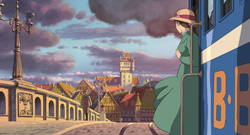
Though the title suggests otherwise, Howl's is really about Sophie, a young woman working in a hat shop who encounters a mysteriously handsome stranger in the streets one day. This encounter sets off a long chain of events and encounters, as Sophie encounters a witch (whose curse on Sophie ignites the rest of the film), a talking flame, an apprentice, a scarecrow with a turnip head and of course, the enormous moving castle. The storyline is vintage Studio Ghibli, weaving normal settings with magical elements to create a hybrid world where you know some of this stuff is implausible in reality, but you could not care less because of this amazing imaginative world that the filmmakers have created.
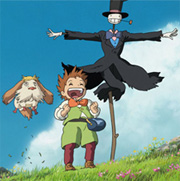
In addition to the beautiful colors, the strong and wonderfully diverse cast of characters is this film's greatest strength. The characters are more or less stereotypical, yet their physical appearances and interactions with each other ensure a unique feel to it all. Sophie is your vintage vulnerable protagonist, Howl is the brooding guy with a heart of gold, Calcifer is the spastic sidekick, Markl is the curious assistant, the Witch is evil but not as cruel as you would think. These characters are both easily identifiable in the roles they fill, while charmingly original in the flair they bring to those roles.
I won't go so far as to proclaim that this is the Best! Ghibli! Ever! - but this is a visually spectacular treat that shows Miyazaki and Studio Ghibli are still chugging along.
Panda! Go Panda!
by: Grace Lin
Synopsis
The movie Panda! Go Panda! is composed of two episodes, "Panda Family!" and "Circus in the Rain", starring the little girl Mimiko, Panny the baby Panda, and Papa Panda. The three characters go through a series of fun and silly events which lead up to a happy ending in each of the two episodes.
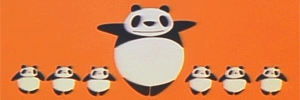
Review
The movie was produced in 1972 with Takahata Isao as the director and the story, scripts, and layout by Miyazaki Hayao. Panda! Go Panda! was made for young children who are oblivious to the troublesome details in life. From the opening credits of dancing pandas to the ending credits of shots from the movie, everything is delightfully simple.
Accompaniment music is limited to variations of the few tunes introduced in the beginning of the movie. However, different moods are conjured by the different tempos and instruments used to perform the tunes. Music to happy moments have a carribean feel to them due to the light percussion, displays of cuteness by Panny and his friend Tiny the tiger in the second episode are presented with the same tune played on the xylophone.
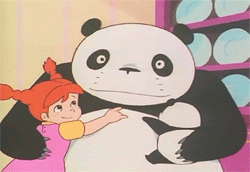
Most of the characters and events are quite impossible in real life. But these are the things which make the movie appeal to the younger audience. Older viewers may first be baffled by the appearance of talking pandas Papa Panda and Panny, then the family formed between Mimiko and the two pandas with Mimiko as Mama to Panny and Papa Panda as father to Mimiko and Panny. But if one can get past these abnormal phenomena, the rest of movie becomes very fun to watch.
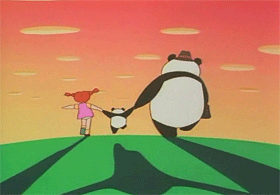
The artwork is very elementary with mostly solid patches of colour. This plain colouring adds to the air of childhood when everything is fun and easy. Objects in the movie are also formed of basic shapes, such as the clouds which are ovals of varying sizes most of the time. Most of the things in the movie are from the western culture, for example, the house in which Mimiko and the pandas live in are mildly similar to 16th century Dutch houses.
In addition to the art, the movie has a few plot and character references to the western culture. There are references to the Goldilocks story, with Tiny playing the role of Goldilocks and Panny being similar to, of course, the baby bear. However, with Tiny and Panny becoming fast friends, the moral of the Goldilocks story is not present in Takahata's film. The character of Mimiko can be seen as a reference to Pippi Longstockings without the mischief and with all the energy.
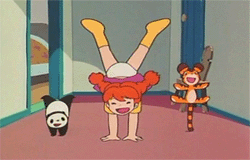
Panda! Go Panda! is a wonderful movie to watch when one wants to leave everyday troubles behind. The simple animation, music and plot are easy on the eyes and mind. There might be people who dislike how simple everything is and how easily situations resolve themselves, but the silliness with which everything is done balances it out to make the movie very lovable.
My Neighbor Totoro by: Julz
Two young girls, Satsuke and her younger sister Mei, move into a house in the country with their father to be closer to their hospitalized mother. Satsuke and Mei discover that the nearby forest is inhabited by magical creatures called Totoros. They soon befriend these Totoros, and have several magical adventures.

This is a gentle, and enchanting movie which is easy to fall in love with. Children and anime fan anime fan alike will be swept away. The theme is mystical and imaginative. One thing that really attached me to this movie is the freedom, sincerity and variety of emotional expression the characters use (especially the two young girls and Totoro, their furry forest friend). There are lot of magical adventures to be found in this movie, from flying with umbrellas to catching a giant living (and "meowing") cat bus that leaps from tree top to tree top to get around. Although the girls' mother is in the hospital, and the youngest girl, Mei, gets lost (and found), there is nothing dirturbing about this movie. It is very gentle. The animation is colorful and expressionate, and the characters are youthful, lovable, and free spirited. All in all it is an enjoyable, lovable, and imaginative adventure.
This movie will make you feel like a kid again, thanks to all the lively characters!
Princess MononokeReviewby: Julz 
A masterpiece, not just an Anime. An original modern fable. It ranks up there with other Anime classics such as Akira and Metropolis. For anyone interested in the genre this is a
must see.
Princess Mononoke is one of the most original and unique movies I've seen, even if it is a cartoon. It doesn't draw from any particular genre or type, the closest I can think of in terms of heritage is the Ainu people of northern Japan, who seem to have been the inspiration for the look and feel of it. Despite it being a cartoon there is a considerable level of violence, and the situations are geared towards adults (animation is definitely not just for children). The film is quite serious, playing upon the theme of man vs. nature. It contains many epic qualities such as journeying heroes, wars, and involvement from supernatural gods, however, there is a lack of any sort of romantic love.
Unfortunately, like most anime that maded to the west, the quality of dubbing can be improved. Billy Crudup's plays a very emotionless Ashitaka, Billy Bob Thornton's Texan accent destroyed the character and the setting, and Claire Danes completely degrades San's noble character with a whiny, valley-girl tone. Hollywood stars just don't have a grip of the anime. It is strongly recommanded that you watch the Japanese version with English subtitles, the voice acting is much better. Sadly, in the upcoming DVD release, there is no japanese language version.
This movie will probably stand for years to come as one of the very few truly original modern fables. It is another Miyazaki masterpiece: Beautiful animation, mystical fern-gullyesque settings, and subtle music which complements the serious nature of the film.
SynopsisThe film follows Ashitaka, a prince of the disappearing Ainu tribe, who is cursed by a demonised boar god and must journey to the west to find a cure from the Forest Spirit. Along the way, he encounters San (The Princess Mononoke), a young human woman fighting to protect the forest and Lady Eboshi, the head of Tatara Ba (Iron Town). Ashitaka is forced to find a middle ground between the two ambivalent forces.
Based on Japanese folklore, "Princess Mononoke" is a riveting piece which is moving and touches upon subjects that are still relevant today - questions of war, ecology, morals and principles.
Tales from EarthseaFilm Synopsis
A sailing ship is rolling in the rough sea. The captain orders the weatherworker to calm the sea, but the weatherworker is unable to remember the true name of the sea and the wind despite his efforts. Then suddenly, two dragons appear from the dark clouds. The dragons were devouring one another. For the dragons living in the end of the West to appear in the eastern ocean area inhabited by humans, and to feed on one another was something unthinkable. The balance of the world was collapsing.
Ged was on a journey, searching for the source causing evil disturbances to the world. Ged — once an impetuous and arrogant goatherd boy — is now a mature man, called by others as "Lord Archmage", the greatest of wizards. During his travels, he meets Arren, Prince of Enlad. The youth was being pursued by a "shadow". The disastrous force destroying the world's balance and driving people mad was nearing Arren as well.
Arren fleeing from his shadow and unable to confront his own inner darkness, was very much like Ged in his younger days. The two traveled down the valley, through the mountain and many deserted ruins. Everywhere, farmers had abandoned their fields. The two arrive to Hort Town, the capital palace. The streets were crowded with people, but craftsmen have forgotten their crafts, items being sold there were all fake, slaves were being traded, and hazia addicts thronged in the backstreets. People bustled about from place to place, but seemed to be without sense of purpose. The people's eyes were fixed on dreams or on death, another world somewhere else.
The two in their quest, seek refuge to Tenar's place, an old acquaintance of Ged. Tenar was once a priestess that guarded the dark Tombs of Atuan when she was a girl. When Ged recovered the broken Ring of Erreth-Akbe from the Tomb, she was brought out to the world of freedom and light by him. Also living in Tenar's house was Therru, a girl whose face was marked with a scar of fire. Therru who had been abandoned by her parents, avoids Arren who holds darkness within and occasionally devastated with despair. Arren spends his days laboring in the fields and interacting with nature, taught and guided by Ged how all creation in the universe is realized on a balance. Therru gradually opens her heart to Arren. Yet even during this time, Arren's fear toward the shadow grows severe and he is troubled by nightmares of being chased by the shadow.
Ged is able to find that a wizard named Cob has opened the door between worlds of the living and of the dead, and that this was triggering the imbalance of the world. This man, once called "Cob of Havnor" had been using of the Pelnish Lore of Paln, and calling up any person he wished from the other world, when asked for with money. In his younger days, Ged was infuriated by Cob who had summoned his master's spirit, and forcefully took the wailing and resisting Cob to the Land of the Dead and pushed him off to the bottom of fear. After that, Cob vowed to reform and left for the West, but he had actually sworn to himself to get his revenge on Ged.
Arren who fears that he will be unable to control the violent "other self" finally goes away from Tenar's house. Running away from the shadow and fainting, Arren comes to at Cob's castle. Cob opens the doors between the worlds of the living and the dead in order to gain eternal life, and plans to kill Ged who is in the way. Arren, whose fear of the shadow has come to a head, is given hazia and loses his senses, and finally tells his true name and falls captive to Cob.
Ged and Therru both risk their lives to bring back Arren to his senses. With their help, Arren overcomes temptation to get eternal life, draws out the sword forged by magical powers and stand face to face with Cob.
Copyright © 2006 by Studio Ghibli
This synopsis was sent to
Ursula K. Le Guin (the author of Tales from Earthsea) directly by Studio Ghibli.
article taken from
www.flickr.com/.../in/set-72157600320399136/

















 The latest movie from the production line of Studio Ghibli, Neko no Ongaeshi is a light-hearted movie as digestible as chicken soup. Directed by Morita Hiroyuki, the movie is based on the manga Baron, Neko no Danshaku by Hiiragi Aoi, who is also the author of Mimi wo Sumaseba and its sequel Mimi wo Sumaseba: Shiawase na Jikan.
The latest movie from the production line of Studio Ghibli, Neko no Ongaeshi is a light-hearted movie as digestible as chicken soup. Directed by Morita Hiroyuki, the movie is based on the manga Baron, Neko no Danshaku by Hiiragi Aoi, who is also the author of Mimi wo Sumaseba and its sequel Mimi wo Sumaseba: Shiawase na Jikan.



 comes to creating gorgeous panoramic scenes, diverse character designs and finishing things off with a flourish when the colors are applied. It can't be underestimated how the wide range of colors used in this film really help things stand out even more and accentuate the fantastical aspects of this film. Yes, the mood for the most part is grim throughout the movie.
comes to creating gorgeous panoramic scenes, diverse character designs and finishing things off with a flourish when the colors are applied. It can't be underestimated how the wide range of colors used in this film really help things stand out even more and accentuate the fantastical aspects of this film. Yes, the mood for the most part is grim throughout the movie.






 A masterpiece, not just an Anime. An original modern fable. It ranks up there with other Anime classics such as Akira and Metropolis. For anyone interested in the genre this is a must see.
A masterpiece, not just an Anime. An original modern fable. It ranks up there with other Anime classics such as Akira and Metropolis. For anyone interested in the genre this is a must see.






Hi, while i was searching for a anime picture, i found your blog... I overfly your text and i was surprised if you don't like anime, that's fine, just leave it alone, why force your self to watch it, and even to write a blog about it.
Big eyes,speeds lines represent animes.without it,it's just not mangas anymore, get it?
I agree that not all animes are good, but you should choose which one to watch.
Azumanga Daioh....how old are you? My 10 years old sister would love to watch it with you.
animes are not always for kids, some animes are made for young adults, which had more serious messages in the story. like -EVA- and -Ghost in the shell-
If you have watched -EVA--Ghost in the shell--full metal alchemist- and other GOOD animes, you'll be surprised.
If you still simply just don't like animes and mangas. fine. but please don't influence others, thank you.